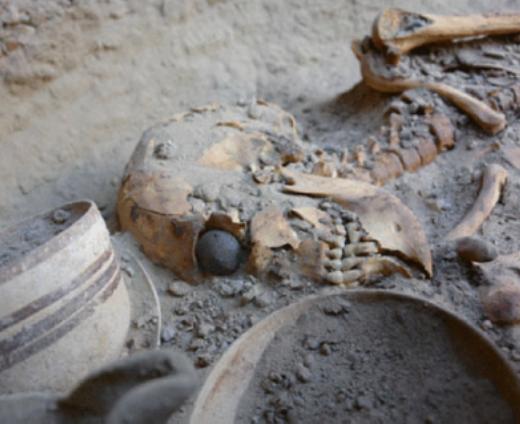The eye prostheses in this box are made by F. Ad. Müller en Söhne, an institute for eye prostheses founded in 1860. Petra Showenhower, "Het Glazen Oog van de Meester," Trouw, 26 april 2013, https://www.trouw.nl/nieuws/het-glazen-oog-van-de-meester ~b9db8d6c/. Although the institute has been around for over 160 years, it was by no means the first manufacturer of eye prostheses. Artificial eyes have been made for thousands of years. The oldest surviving case comes from a woman in Iran around 2900-2800 B.C. (photo 1) This artificial eye was made of bitumen paste and a thin layer of engraved gold. She wore it with a gold thread around the head, on top of the eye socket. This form of external eye prosthesis is called ekblepharon. The Egyptians and Romans also made this type of artificial eyes around the 5th century B.C. from painted clay, and they tied them around the head with strips of cloth. Keith Pine, Brian H. Sloan and Robert J. Jacobs, Clinical Ocular prostethics, 1st ed. (Cham: Springer 2015), 295.
Due to the absence of writings and objects, we do not really know what happened in the field of eye prosthetics after this time. The next eye prosthesis that we know of only stems from the 16th century, when illustrations of an ekblepharon by the French physician Ambroise Paré were published in the book Les Oeuvres d’Ambroise. (photo 2) Keith Pine, Brian H. Sloan and Robert J. Jacobs, Clinical Ocular prostethics, 1st ed. (Cham: Springer 2015), 287. This prosthesis consisted of an eye, complete with eyelids and eyelashes, and was bent around the head by means of a leather-wrapped metal rod. Polina Llieva, ‘Upcoming Lecture & Exhibit: History, Science and Art of Ocular Prosthetics,’ Brought to Light, 25 April 2015, https://broughttolight.ucsf.edu/2015/04/24/1751/. He is also the first known person to recommend prosthetics for in the eye socket; this type of prosthesis is called hypoblephara. And although older cases of this type of eye prosthesis have been found, their origin is unfortunately unknown. These French artificial eyes were made by goldsmiths from enameled gold and silver, and although very beautiful, they quickly became dull and repelled tear fluid.Neil Handley, "Artificial Eyes and the Artificialization of the Human Face," in Devices and Designs
Medical Technologies in Historical Perspective, eds. Carsten Timmermann, Julie Anderson (London: Palgrave Macmillan, 2006), 100- 101.
The French were quickly challenged by competition from Venice and, later in the 17th century, Augsburg. There they produced glass eye prostheses made by glassblowers. These were more realistic, lasted longer and did not react with tear fluid. Unfortunately, they were also thin and fragile, making them uncomfortable to wear.Keith Pine, Brian H. Sloan and Robert J. Jacobs, Clinical Ocular prostethics, 1st ed. (Cham: Springer 2015), 287.
In the late 18th century, Paris turned into the center for artificial eyes. The enameled, gold eyes were now made with a mixture of silicon, potassium, lead and tin.Keith Pine, Brian H. Sloan and Robert J. Jacobs, Clinical Ocular prostethics, 1st ed. (Cham: Springer 2015), 290-295. However, these eyes were quite expensive and the material still caused problems with dullness and tear fluids.Neil Handley, "Artificial Eyes and the Artificialization of the Human Face," in Devices and Designs
Medical Technologies in Historical Perspective, eds. Carsten Timmermann, Julie Anderson (London: Palgrave Macmillan, 2006), 100- 101.
So eye prostheses were made in abundance throughout history, but there was still much to be gained in terms of comfort and price. Fortunately, in the 19th century Ludwig Müller-Uri thought of a solution. This German glassblower manufactured the first eye prosthesis from cryolite glass.Keith Pine, Brian H. Sloan and Robert J. Jacobs, Clinical Ocular prostethics, 1st ed. (Cham: Springer 2015), 290-295. This material was stronger, cheaper and did not react with the tear fluid. In addition, in 1880, together with the Utrecht ophthalmologist Herman Shellen, Müller-Uri designed the “reform eye prothesis”: the same prosthesis as can be found in this box. These prostheses were double-walled, thick and crescent-shaped, so they remained in the eye socket and rotated better. These glass eyes were such an improvement that glass eye prostheses are manufactured in this same way to this day.Marten Minkema, 'Het oog wil ook wat,' VPRO, 19 december 2017, https://www.vpro.nl/lees/artikelen/2017/het-oog-wil-ook-wat.html. However, plastic eye prostheses have also entered the market since 1950. These are easier to manufacture and cheaper, but also water-repellent and less sparkly than glass. Marten Minkema, 'Het oog wil ook wat,' VPRO, 19 december 2017, https://www.vpro.nl/lees/artikelen/2017/het-oog-wil-ook-wat.html.

